We have so many things to do at the moment that getting the solar equipment running is on the back burner. I have managed to make a little progress on installing the solar panels.
I searched the web and believe I have found the ideal angles for the solar panels for winter and not winter (the proper angle is entirely a function of latitude, ours is 31° 50′ 7″ N, and the angle of the sun). You could, I imagine, adjust the angle of your solar panels constantly. Most people just pick a angle somewhere in between the summer and winter ideals. Some people adjust their angles four times a year. I’ve settle on two angles, winter (57°) and spring, summer, fall (28°). My thinking on this is that adjusting the angles will be a pain, and I won’t want to adjust them very often. There are fewer hours of daylight in the winter so the angle during the winter months will be most important. During the summer months we get lots of hours of sun so having the perfect angle is not really that important. Therefore, winter and not winter angles.
You might wonder about the solar panel mounts that track the sun automatically. Unless the price drops dramatically, they are not practical. They provide very little additional power; it’s a better value to buy extra solar panels. Also, they are a moving part, and moving parts break.
In order to make adjusting the panels easy and to make sure I remember the proper angles, I cut two pieces of OSB each to one angle. Here is the winter angle propped up and facing south.
We ended up getting twelve 210 watt panels. They will be mounted in two rows of six, one in front of the other. You never want shadows on your solar panels (enormous decrease in power output) so I need to position the front row accordingly. I could just compute the proper distance, but it’s close enough to the solstice that I’m just waiting until then to measure the proper placement. I’m thinking about ten feet should do it, but will find out for sure on December 21st.
The solar panel mounts we are using will sit on concrete posts. I started digging the holes. I find digging to be one of the more daunting tasks we do. So daunting, that it always goes better then I imagined. So far, so good. I finished two holes today and started three more. There are ten posts for a row of solar panels, and each row has a front and back row of five posts. I’m starting with the back row. Once it’s done I will assemble a mount and put one panel on in order to decide how far apart the two row needs to be so I can make the adjustments for the two angles I need. The back row has an adjustable arm and I can see that if it’s too far apart you’ll never get the proper winter angle. If it’s too close together, it’ll be weak. The wind here is too fierce to have any weakness in the mounting.
I poured the first two columns today…
Getting out the air pockets using a hammer drill as a concrete vibrator
The plan is hook up the first row of solar panels as soon as we can and add the second row at our leisure. I can’t wait to start powering our tools from the sun. Our generator has been awesome, but it’s noisy and getting gasoline for it is a bother. And getting the solar working is one more step toward our move-in.

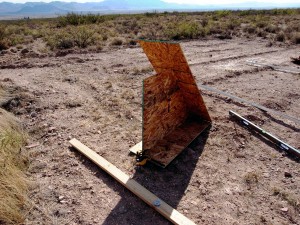
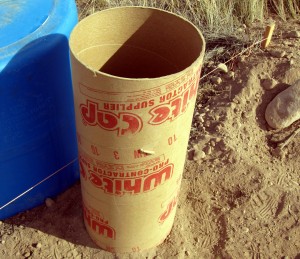
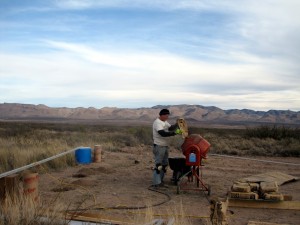
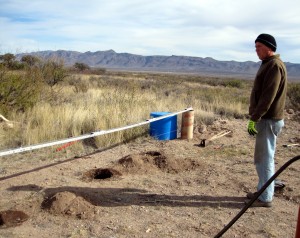
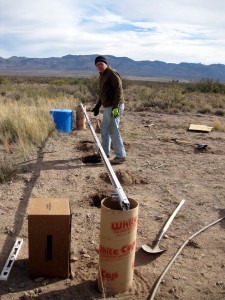
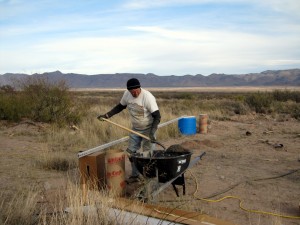
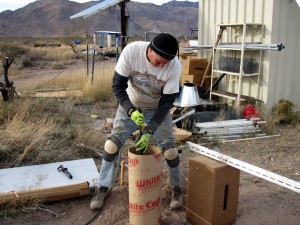
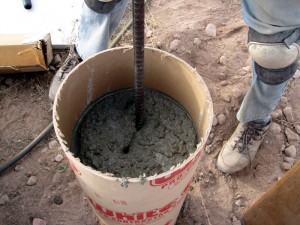
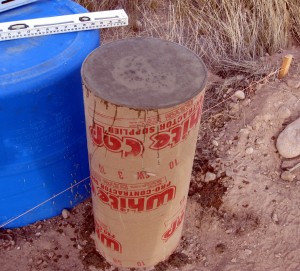
Putting solar on the back burner sounds like you secretly an oil man trying to update his image…Now when a conflict occurs, you show your true nature [grin]
Stick with it. We who have no skills are watching intently and cheering from the sidelines as you work the front lines in our behalf, proving it can be done and inspiring us.
Here’s something for you to put on the second stove’s back burner. It’s not ready for you, but sounds like a technology to watch.
http://www.newscientist.com/article/dn18237-cheap-catalyst-can-make-and-break-hydrogen.html
Yes, there’s a lot of interesting research in this area. High tech flywheels are one, another is a battery inspired by photosynthesis from MIT.
http://www.engadget.com/2008/08/01/mit-develops-solar-storage-nirvana-energy-crisis-solved/